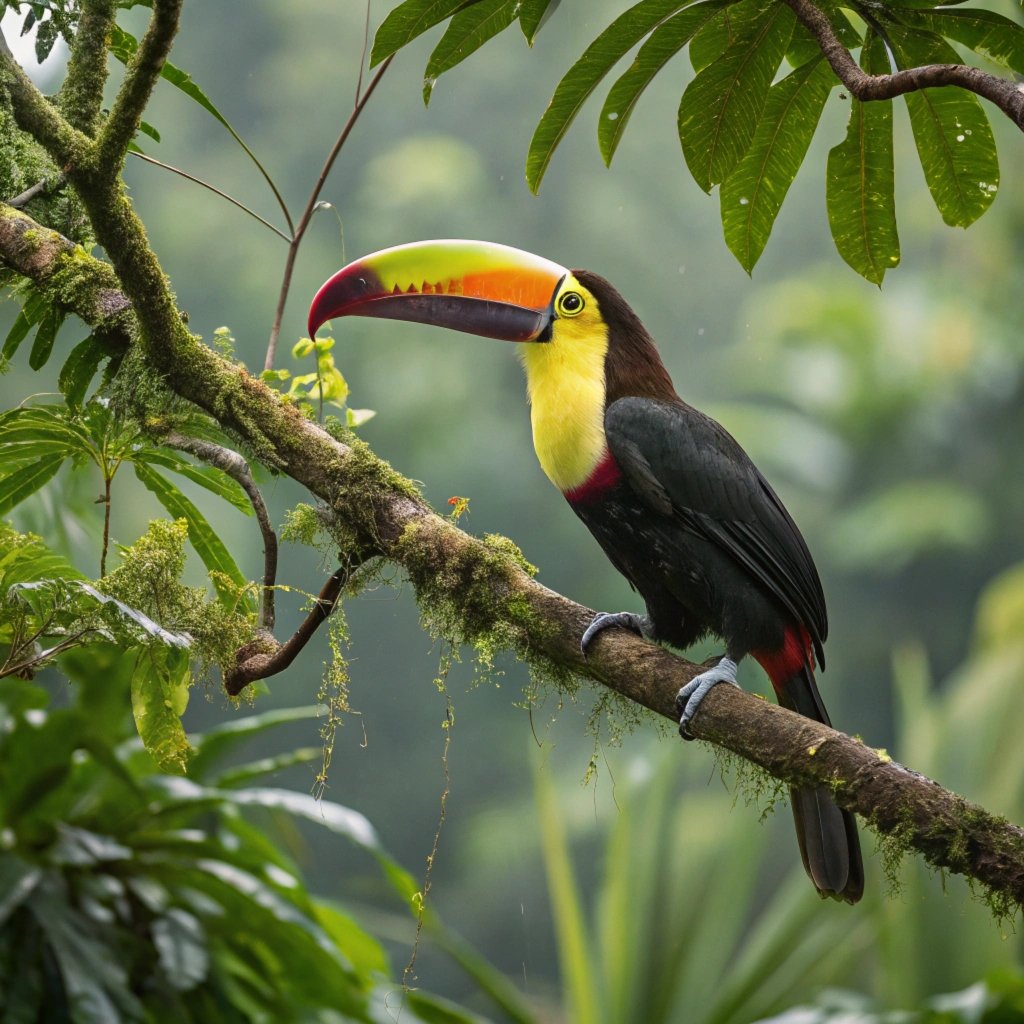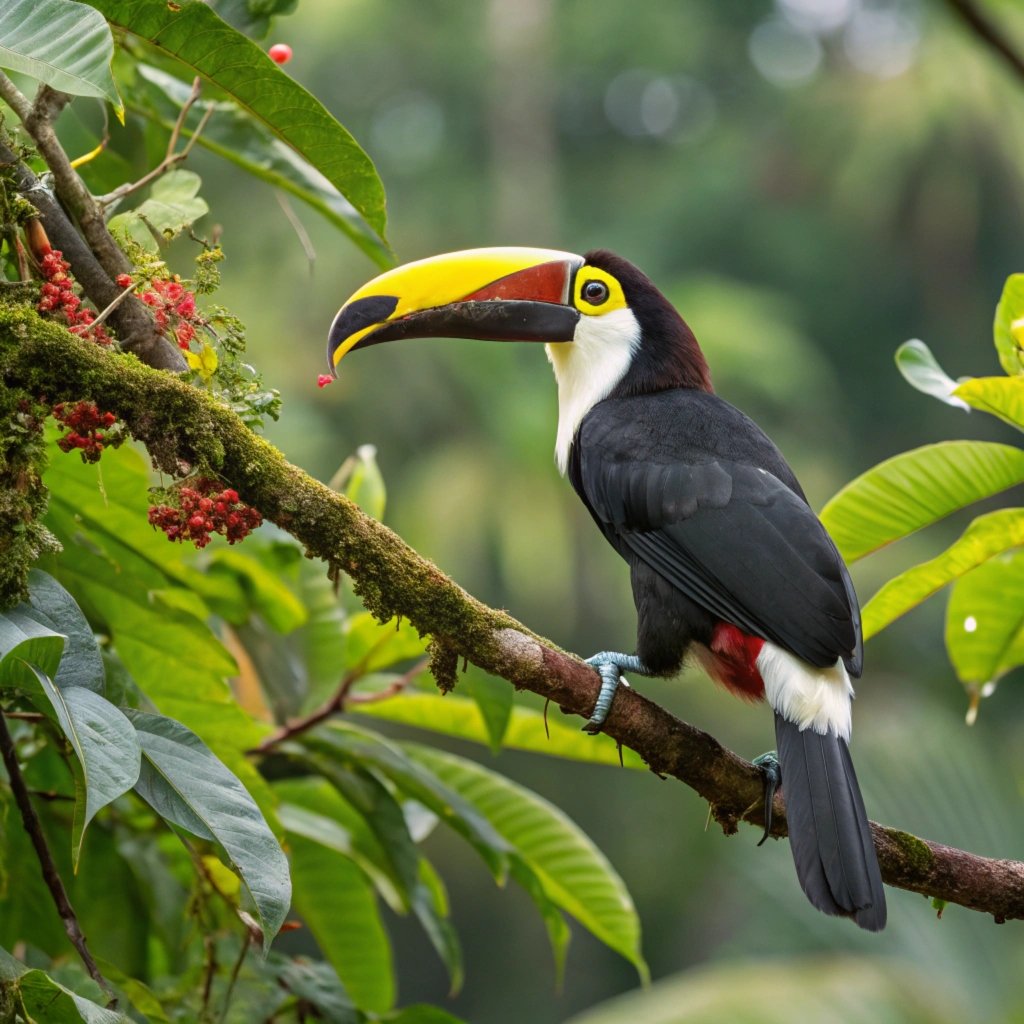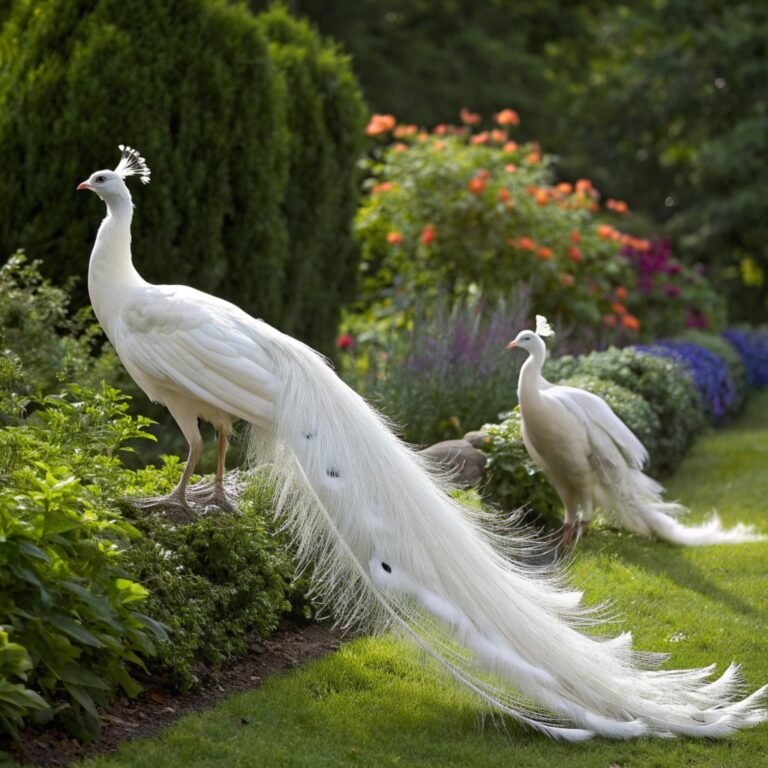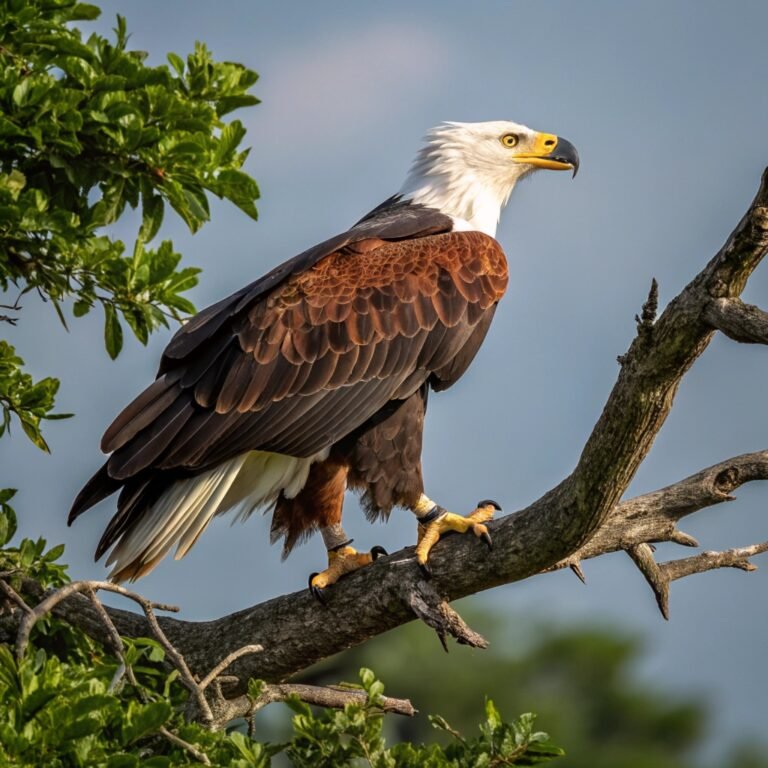The Fascinating World of the Choco Toucan: A Comprehensive Guide to This Unique and Colorful Species
The Choco Toucan, scientifically known as Ramphastos brevis, is a captivating bird species that inhabits the humid forests of northwestern South America.
This comprehensive guide delves into the various aspects of this unique toucan, from its distinctive appearance to its behavior and conservation status.

Key Takeaways:
- The Choco Toucan is a medium-sized toucan species found in the Choco region of Colombia and Ecuador.
- It has a distinctive appearance with a black body, white throat, and a large, colorful bill.
- The species inhabits lowland and foothill rainforests up to elevations of about 1,550 meters.
- Choco Toucans are primarily frugivorous but also consume insects and small vertebrates.
- They are social birds often seen in small groups or pairs.
- The species is currently listed as Near Threatened by the IUCN due to habitat loss and hunting.
- Choco Toucans play a crucial role in seed dispersal within their forest ecosystems.
- Their unique vocalizations, including croaking calls and bill clattering, are important for communication.
- The breeding season typically occurs between June and August, with nests built in tree cavities.
- Conservation efforts focus on protecting their forest habitats and reducing hunting pressures.
Taxonomy and Classification: Placing the Choco Toucan in the Avian Family Tree
The Choco Toucan belongs to the family Ramphastidae, which includes all toucans, toucanets, and aracaris. Its scientific classification places it in the genus Ramphastos, which encompasses the “true toucans.”
Previously considered a subspecies of the Yellow-throated Toucan (Ramphastos ambiguus), the Choco Toucan was elevated to full species status based on vocal differences and other distinct characteristics.
This reclassification highlights the importance of ongoing research in avian taxonomy. The Choco Toucan is monotypic, meaning it has no recognized subspecies.
Its closest relative is the Channel-billed Toucan (Ramphastos vitellinus), with which it forms a sister species relationship.
Physical Characteristics: The Striking Appearance of the Choco Toucan

The Choco Toucan boasts a striking appearance that sets it apart from other bird species. Measuring 46 to 48.5 cm in length and weighing between 365 to 482 grams, it is a medium-sized toucan with a robust build.
The most notable feature is its large, colorful bill, which has a yellow maxilla with some green on the culmen and a black triangle at its base.
The mandible is predominantly black, sometimes featuring a yellow tip. The toucan’s body is primarily black, with a maroon tinge on the crown and nape.
Its throat and breast are a vibrant yellow, separated from the black belly by a narrow red band.
The uppertail coverts are white, providing a stark contrast to the black tail feathers. Around the eye, there is an area of bare skin that ranges from yellow-green to olive green in color.
Habitat and Distribution: The Choco Toucan’s Range in South America
The Choco Toucan is endemic to the humid Chocó region, a biogeographic area stretching from northwestern Colombia to southwestern Ecuador along the Pacific slope of the Andes.
This region is renowned for its high biodiversity and unique ecosystems. The toucan’s habitat primarily consists of lowland and foothill rainforests, where it thrives in the dense, wet environment.
These birds are adaptable and can also be found in pastures and plantations adjacent to forested areas, provided there are fruiting trees available.
The Choco Toucan’s vertical distribution extends from sea level up to elevations of approximately 1,550 meters (5,100 feet) above sea level.
This range encompasses a variety of forest types, from tropical lowland rainforests to cloud forests at higher elevations.
Behavior and Social Structure: Understanding Choco Toucan Interactions

Choco Toucans exhibit fascinating social behaviors that contribute to their survival and reproduction in the forest ecosystem.
These birds are typically observed in small groups or pairs, indicating a social structure that balances cooperation and individual needs.
Their daily activities revolve around foraging, with groups moving through the forest canopy in search of food.
Choco Toucans are known to engage in upslope and downslope movements while foraging, adapting their location based on food availability and environmental conditions.
During breeding season, pairs become more territorial and engage in courtship displays.
These displays often involve swinging their heads back and forth while vocalizing, a behavior that strengthens pair bonds and signals readiness to mate.
Diet and Feeding Habits: The Varied Menu of the Choco Toucan
The Choco Toucan’s diet is primarily frugivorous, but these birds are opportunistic feeders with a diverse palate. Their large, serrated bill is perfectly adapted for plucking and manipulating fruits of various sizes.
While fruits make up the majority of their diet, Choco Toucans also consume insects and small vertebrates, providing them with essential proteins and nutrients.
They forage mainly in the forest canopy, using their agile movements to navigate through branches and reach food sources.
Interestingly, Choco Toucans have been observed following army ant swarms, a behavior that allows them to prey on small animals flushed out by the ants.
This adaptable feeding strategy helps them maintain a balanced diet and survive in their dynamic forest environment.
The toucan’s role as a frugivore is particularly important for forest ecology, as they contribute significantly to seed dispersal.
Breeding and Reproduction: The Nesting Cycle of Choco Toucans
The breeding season for Choco Toucans typically occurs between June and August, although in some regions of Colombia, it may begin earlier.
During this period, pairs engage in elaborate courtship rituals to strengthen their bond and prepare for nesting. The nesting process begins with the selection of a suitable site, usually a tree cavity or an abandoned woodpecker hole.
Both male and female participate in preparing the nest, which is lined with regurgitated seeds and other soft materials.
Females typically lay 2 to 4 white eggs, which are incubated by both parents for about 16 to 17 days.
This shared incubation duty demonstrates the cooperative nature of Choco Toucan pairs during the breeding season.
After hatching, the chicks are born altricial, meaning they are helpless and require extensive parental care.
Vocalizations and Communication: The Unique Sounds of the Choco Toucan
Choco Toucans possess a diverse vocal repertoire that plays a crucial role in their communication and social interactions.
Unlike some other toucan species that produce yelping calls, the Choco Toucan is known for its distinctive croaking vocalizations.
Their primary call is described as a steadily repeated series of croaking “kreeork” notes, which can sometimes speed up into a sharper “kriik” sound.
These vocalizations serve multiple purposes, including territorial defense, mate attraction, and group coordination.
In addition to their vocal calls, Choco Toucans engage in non-vocal sound production. One notable behavior is bill clattering, where they rapidly tap their bills together to create a loud clacking noise.
Conservation Status: Challenges and Efforts to Protect the Choco Toucan
The Choco Toucan is currently listed as Near Threatened by the International Union for Conservation of Nature (IUCN). This status reflects the growing concerns about the species’ long-term survival due to various threats.
The primary challenges facing Choco Toucans include habitat loss and fragmentation caused by deforestation, agricultural expansion, and urban development in their native range.
Additionally, the species faces pressure from hunting for food and traditional medicine practices. While the exact population size is unknown, it is believed to be decreasing.
Conservation efforts for the Choco Toucan focus on protecting and restoring their forest habitats. Several protected areas have been established in Colombia and Ecuador to safeguard the species and its ecosystem.
However, more research is needed to fully understand the Choco Toucan’s ecological requirements and to determine whether its current conservation status needs reassessment.
Ecological Role: The Choco Toucan’s Impact on Forest Ecosystems
The Choco Toucan plays a vital ecological role in its forest habitat, contributing significantly to the ecosystem’s health and biodiversity. As primarily frugivorous birds, they are important seed dispersers for a wide variety of plant species.
When Choco Toucans consume fruits, they often swallow the seeds whole and later deposit them in new locations through their droppings.
This process of seed dispersal is crucial for forest regeneration and maintaining plant diversity across their range.
The toucan’s ability to move seeds over relatively long distances helps in the genetic exchange between plant populations and the colonization of new areas.
Additionally, their feeding habits can influence the spatial distribution of plant species within the forest. The Choco Toucan’s role extends beyond seed dispersal.
As predators of small animals and insects, they contribute to controlling populations of various forest invertebrates and small vertebrates.
Adaptations and Survival Strategies: How Choco Toucans Thrive in Their Environment
Choco Toucans have evolved several unique adaptations that enable them to thrive in their forest habitat. Their most notable feature, the large and colorful bill, serves multiple purposes beyond its role in feeding.
The bill’s size and serrated edges make it an effective tool for reaching and manipulating fruits that might be inaccessible to other birds.
Despite its size, the bill is surprisingly lightweight, composed of a honeycomb-like structure of bone struts filled with spongy tissue. This design allows for strength without adding excessive weight, crucial for the toucan’s arboreal lifestyle.
The bill also plays a role in thermoregulation, with blood vessels that can dilate or constrict to help regulate body temperature.
Choco Toucans have strong, zygodactyl feet (two toes facing forward and two backward) that provide a secure grip on branches, allowing them to navigate the forest canopy with ease.
Human Interactions: The Cultural Significance and Impact of Choco Toucans
Choco Toucans have long held cultural significance in the regions where they occur, often featuring in local folklore, art, and traditional practices.
Indigenous communities in the Chocó region have historically viewed these birds as important elements of their natural and spiritual world.
In some areas, Choco Toucans have been hunted for food and their bills and feathers used in traditional crafts. However, this practice has contributed to population declines in certain areas.
The striking appearance of the Choco Toucan has also made it a popular subject in wildlife photography and ecotourism, bringing economic benefits to local communities through sustainable bird-watching activities.
As awareness of conservation issues grows, there’s an increasing effort to balance traditional uses with the need to protect the species.
Educational programs in local communities aim to highlight the ecological importance of Choco Toucans and promote their conservation.
Research and Scientific Importance: Ongoing Studies on Choco Toucans
Scientific research on Choco Toucans continues to yield valuable insights into their biology, ecology, and conservation needs.
Current studies focus on various aspects, including their population dynamics, breeding biology, and habitat requirements.
Researchers are using advanced tracking technologies to better understand the species’ movements and home range sizes, which is crucial for effective conservation planning.
Genetic studies are helping to clarify the Choco Toucan’s evolutionary history and its relationships with other toucan species.
This research is particularly important given the relatively recent recognition of the Choco Toucan as a distinct species.
Ecological studies are examining the toucan’s role in seed dispersal and its impact on forest composition, providing valuable data for forest restoration efforts.
Conservation biologists are also investigating the effects of habitat fragmentation and climate change on Choco Toucan populations, aiming to develop more effective protection strategies.
Threats and Challenges: Factors Affecting Choco Toucan Populations
The Choco Toucan faces several significant threats that impact its population and long-term survival. The primary challenge is habitat loss and fragmentation due to deforestation, agricultural expansion, and urban development in its native range.
As large areas of forest are converted for human use, the available habitat for Choco Toucans shrinks, affecting their ability to find food, nesting sites, and mates.
Climate change poses an additional threat, potentially altering the distribution of plant species that the toucans rely on for food and affecting the timing of fruiting seasons.
Hunting pressure remains a concern in some areas, where Choco Toucans are targeted for food or traditional practices.
The illegal pet trade, although not as significant as for some other toucan species, still poses a threat to local populations. Competition with invasive species for food and nesting sites can also impact Choco Toucan populations in some areas.
Conservation Strategies: Efforts to Protect and Preserve Choco Toucans
Conservation efforts for the Choco Toucan focus on several key strategies to protect this unique species and its habitat. One of the primary approaches is the creation and expansion of protected areas.
Organizations like Fundación Jocotoco are working to expand existing reserves, such as the Canandé Reserve, to create larger continuous protected areas.
This effort aims to connect the reserve with the Cotacachi Cayapas Reserve and other nearby state-run protected areas, potentially creating a 300,000-hectare continuous protected area.
Habitat restoration is another crucial strategy. Aves y Conservación, for example, has established the Kinti Toisán reserve, which includes both intact and degraded forest areas.
The organization is working to restore degraded areas, increasing suitable breeding habitat for the Choco Toucan and other endangered species like the Black-breasted Puffleg.
Research and monitoring play a vital role in conservation efforts.
The Chocó lab, established by Fundación Jocotoco in the Canandé Reserve, serves as a research station where experts study various aspects of the forest ecosystem, including bioacoustics for bird monitoring and forest recovery.
This research provides valuable data for conservation planning and management.
Community engagement and support for local communities are essential components of conservation strategies.
Efforts are being made to support local communities in legally defending their lands and promoting sustainable practices that are compatible with toucan conservation.
FAQs
What is the scientific name of the Choco Toucan?
The scientific name of the Choco Toucan is Ramphastos brevis.
Where can Choco Toucans be found in the wild?
Choco Toucans are found in the humid Chocó forests of northwestern Colombia and southwestern Ecuador, along the Pacific slope of the Andes.
What is the conservation status of the Choco Toucan?
The Choco Toucan is currently listed as Near Threatened by the International Union for Conservation of Nature (IUCN).
What is the main diet of Choco Toucans?
Choco Toucans are primarily frugivorous, feeding on a variety of fruits. They also consume insects and small vertebrates.
How do Choco Toucans communicate?
Choco Toucans communicate through various vocalizations, including croaking calls and bill clattering. Their primary call is described as a series of croaking “kreeork” notes.
What are the main threats to Choco Toucans?
The main threats to Choco Toucans include habitat loss and fragmentation due to deforestation, agricultural expansion, and urban development. They also face pressure from hunting and the illegal pet trade.
How do Choco Toucans contribute to their ecosystem?
Choco Toucans play a vital role in seed dispersal, contributing to forest regeneration and maintaining plant diversity in their habitat.
What is unique about the Choco Toucan’s bill?
The Choco Toucan’s bill is large and colorful, primarily yellow with some green on the upper part and black on the lower part. Despite its size, the bill is lightweight due to its honeycomb-like structure.
How do Choco Toucans nest?
Choco Toucans nest in tree cavities, often using abandoned woodpecker holes. They typically lay 2-4 white eggs, which are incubated by both parents.
What conservation efforts are in place to protect Choco Toucans?
Conservation efforts include creating and expanding protected areas, habitat restoration, research and monitoring, community engagement, and addressing specific threats like deforestation and illegal hunting.

Hello, I’m Emily Price, the founder of Birds Affection. As a passionate bird enthusiast and spiritual seeker, I’ve always been fascinated by the symbolic meanings and mystical connections between birds and our lives. On this website, I share my knowledge and insights on the spiritual significance of various bird species, exploring their roles as messengers, guides, and teachers. Through my writing, I aim to inspire and educate others on the profound wisdom and beauty that birds bring to our world. Join me on this journey as we delve into the enchanting realm of bird symbolism and discover the hidden meanings behind these magnificent creatures.







